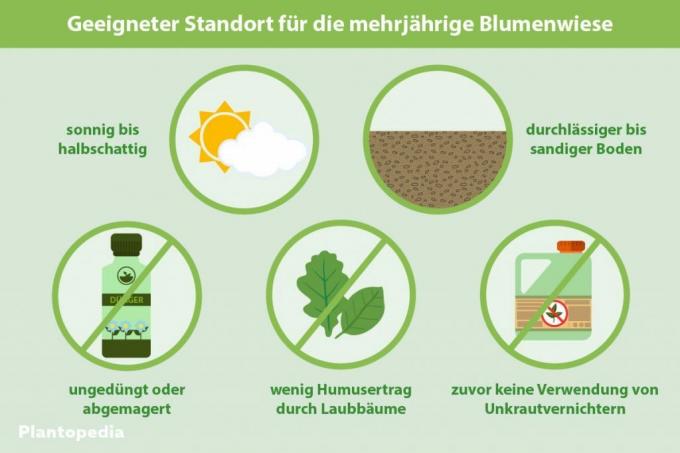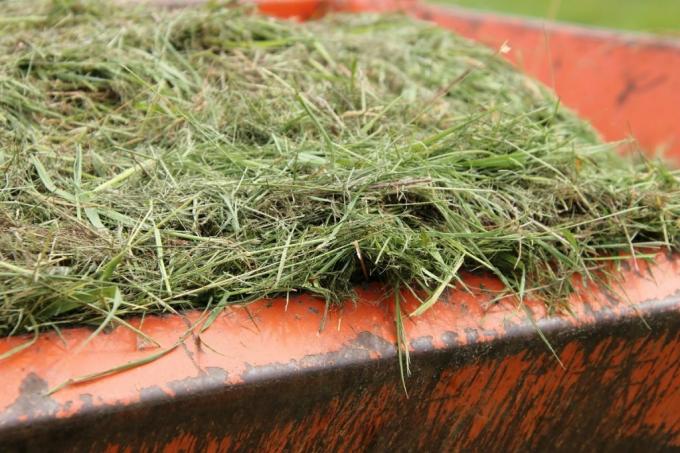
table of contents
- Make preparations
- Lean location
- Select the right seeds
- Instructions: Create perennial flower meadow
- Maintain perennial flower meadow
- frequently asked Questions
A flower meadow not only looks beautiful, it is also a magnet for insects and thus serves to protect species. However, creating a new perennial flower meadow is not as easy as it seems.
In a nutshell
- Meadows of flowers enrich every garden
- provide food for insects and are decorative
- New planting requires some effort so that meadow remains beautiful for several years
- not every soil suitable
- Maintenance measures are then limited
Make preparations
A species-rich flower meadow does not thrive on every surface, especially not over a number of years. For example, a lawn that is frequently fertilized is a very poor location. Flowers need a poor subsoil, otherwise only species that can be fertilized will prevail benefit and over the years fewer and fewer flowers are seen, while grasses become more common will.
Characteristics for a suitable location

Lean location
The most important thing for a species-rich flower meadow that should thrive for several years is a poor substrate. This means that any fertilization of the area is stopped immediately. If an area is naturally to become lean, this usually takes several years. Then a flowering meadow with native species usually emerges on its own, which gradually settle. However, the area has to be left to its own devices.
Instructions for losing weight
- 1. If the soil is very loamy, spread sand. Be generous in doing so. Sprinkle the sand in a thick layer on the surface and then dig over the subsoil.
- 2. When the clods have settled a little, chop the whole area thoroughly and smooth it out. This also makes the soil more permeable.

- 3. If the soil is already permeable enough, it makes more sense for one season Heavy Eater to plant on it. That can be vegetables, but also lawn. So if the area has already been greened, then fertilization is stopped and the lawn is mowed frequently.
- 4. Remove the grass clippings and thus repeatedly deprive the grasses of nutrients. If weeds form, ignore them and just mow with.
Select the right seeds
Not every seed for flower meadows creates a flowering area that remains beautiful for several years or becomes more and more beautiful over time. From the outset, all mixtures that are annual are eliminated; these can at best be mixed with perennial seeds so that flowers bloom in the first year of standing.
The most important characteristic of the right mix is not how many species are included, but whether it is suitable for the selected location. In addition, there should be as few grasses as possible. In a perennial flower meadow, these appear all by themselves over time.

Note: Even if many native plants are decried as weeds, they are the best basis for creating a species-rich flower meadow.
Instructions: Create perennial flower meadow
Prepare the soil
Flower meadow seeds are usually light germs. Therefore, a good soil preparation before creating the flower meadow is very important. The surface is thoroughly loosened. Remove all stones and weeds. Finally, rake the surface very smoothly. For larger areas, install irrigation that covers the entire area.
sowing
Depending on the weather, sowing takes place when the soil has dried a little but is still moist. Best between the beginning of April and mid-May, after which it quickly becomes too warm and dry. However, you can also create a new flowering meadow in autumn. To do this, simply follow the instructions below:

- Mix the seeds with sand or fine soil.
- Spread with a spreader or by hand, making sure that the sowing is even. Quantities are stated on the packaging, it is better to sow a little too much than too little.
- Rake in the seeds lightly. Warning: not too deep, you need light!
- Roll the surface or press the seeds well in another way. They need to have a good connection with the soil in order for them to germinate successfully.
- Water the area. Be careful not to wash away the light seeds.
Care until germination
The most important thing is to keep the area moist for four to six weeks. To do this, rain or water regularly, especially when it is dry. The future flower meadow is also not allowed to be walked on. It is best to ignore germinating weeds, they are usually indistinguishable from the "real" seeds. Bird damage can be a problem under certain circumstances. In this case, set up a self-made scarecrow or cover the area with a net.
Maintain perennial flower meadow
A perennial flower meadow is generally very easy to care for. However, one should not assume that the same flowers will bloom every year. Usually the initially sown species are becoming increasingly rare and are being replaced by other, more competitive ones. The maintenance measures include mowing the meadow once or twice a year at the most.

However, it is difficult to find the right time to do this:
- excretes immediately before and during flowering
- After flowering, seeds begin to form, which is desirable in a flowering meadow
- withered stems provide winter quarters for insects
One possibility is to mow the meadow before the new shoots and the old shoots on one to store loose piles in a shady place so that wintering insects can still leave them can. Should the meadow also be mowed a second time, then only after it has been completely mowed. This can be recognized by empty seed pods.
Mow the flower meadow properly
The lawnmower is ruled out, it is simply not suitable for a flowering meadow. A bar mower has decisive advantages for larger areas. In a small meadow, a scythe and mowing by hand are sufficient. This can also be done very well with flowers that are still in bloom. A flowering meadow is never mowed as short as a lawn and it is also not about mowing the area as neatly as possible. A cutting height of 10 cm is sufficient.

Tip: Always remove cuttings from the meadow. As a result, the site is becoming lean and the biodiversity is increasing.
frequently asked Questions
Not at all. There are no weeds on a flowering meadow. Only plants will prevail if the site is also perennial. Do weeds that need a lot of nutrients prevail (e. B. Dandelion) this indicates that the area is not yet emaciated enough.
For this, the annual mowing is important on the one hand, but also giving the flowers the opportunity to sow themselves on the other.
No, it is absolutely unnecessary. Unless the area is very sandy and poor. But then it is enough to chop the crop and distribute it over the area. Even without fertilizer, a flowering meadow remains beautiful for several years.



